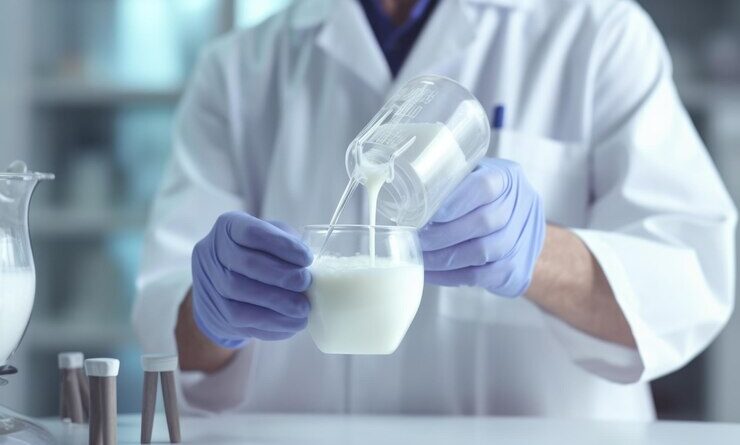How Do You Test Milk Protein?
Milk protein analysis is crucial for ensuring the quality and safety of dairy products. Whether you are a dairy producer, a food manufacturer, or a consumer, understanding how milk proteins are tested can help you assess the nutritional value, identify adulteration, and ensure compliance with regulatory standards. This blog explores the various methods and techniques used in milk protein analysis, highlighting their significance and application in the dairy industry.
Why Test Milk Protein?
Milk proteins play a vital role in the nutritional value and functional properties of dairy products. Testing milk proteins is essential for several reasons:
Nutritional Quality: Determining the protein content in milk helps assess its nutritional value. Proteins are crucial for growth, repair, and overall health.
Product Authenticity: Protein analysis can identify adulteration or dilution of milk with non-dairy substances, ensuring product authenticity.
Regulatory Compliance: Compliance with food safety regulations requires accurate protein content measurement to meet industry standards and labeling requirements.
Quality Control: Regular testing helps maintain consistent product quality and monitor changes due to processing or storage conditions.
Methods for Milk Protein Analysis
Various methods are employed to test milk proteins, each offering unique advantages depending on the specific requirements of the analysis. Here are some commonly used techniques:
Kjeldahl Method
The Kjeldahl method is a traditional and widely used technique for determining the total protein content in milk. It measures the nitrogen content, which is then converted to protein content using a standard conversion factor.
Procedure: The milk sample is digested with sulfuric acid, converting nitrogen in proteins to ammonium sulfate. The digested solution is then neutralized, and ammonia is distilled and quantified. The total nitrogen content is calculated and converted to protein content.
Advantages: This method is reliable and provides a comprehensive measure of protein content, including both casein and whey proteins.
Limitations: The Kjeldahl method does not differentiate between different types of proteins and may not be suitable for specific protein analysis.
Bradford Assay
The Bradford assay is a colorimetric method used for estimating protein concentration based on the binding of proteins to a dye.
Procedure: Milk proteins bind to Coomassie Brilliant Blue dye, causing a color change. The intensity of the color, measured using a spectrophotometer, correlates with the protein concentration.
Advantages: The Bradford assay is quick, simple, and sensitive to low concentrations of protein. It is useful for measuring total protein in milk samples.
Limitations: The assay may be affected by the presence of other substances in milk, such as lipids or detergents, which can interfere with dye binding.
Lowry Method
The Lowry method is another colorimetric technique for protein determination, based on the reaction of proteins with Folin-Ciocalteu reagent.
Procedure: Proteins in milk react with alkaline copper tartrate and Folin-Ciocalteu reagent, resulting in a color change. The intensity of the color, measured spectrophotometrically, indicates protein concentration.
Advantages: The Lowry method is sensitive and can measure low protein concentrations. It is suitable for complex milk samples.
Limitations: The method can be affected by interfering substances and requires careful calibration and handling.
SDS-PAGE (Sodium Dodecyl Sulfate-Polyacrylamide Gel Electrophoresis)
SDS-PAGE is a powerful analytical technique used to separate milk proteins based on their molecular weight.
Procedure: Milk proteins are denatured with SDS and subjected to electrophoresis in a polyacrylamide gel. The proteins migrate through the gel based on their size, and the separated bands are visualized using staining methods.
Advantages: SDS-PAGE provides detailed information on the protein composition of milk, allowing for the identification of individual proteins and their molecular weights.
Limitations: The technique requires specialized equipment and expertise. It does not provide quantitative data on protein concentration.
ELISA (Enzyme-Linked Immunosorbent Assay)
ELISA is an immunoassay technique used to detect and quantify specific milk proteins using antibodies.
Procedure: Milk proteins are captured by specific antibodies immobilized on a plate. A secondary antibody, conjugated with an enzyme, binds to the captured proteins. The enzyme-substrate reaction produces a color change, which is measured spectrophotometrically.
Advantages: ELISA is highly specific and can detect and quantify individual milk proteins. It is useful for identifying proteins of interest and monitoring protein levels.
Limitations: The method requires specific antibodies and may be affected by cross-reactivity or interference from other milk components.
Applications of Milk Protein Analysis
A Milk protein analysis is applied in various contexts to ensure the quality and safety of dairy products:
Quality Assurance: Regular testing helps maintain consistent product quality and ensure that milk products meet nutritional and regulatory standards.
Adulteration Detection: Protein analysis can identify the presence of non-dairy substances or dilution, ensuring the authenticity of milk products.
Nutritional Labeling: Accurate protein content measurement is essential for labeling and providing consumers with reliable nutritional information.
Product Development: Understanding the protein profile of milk helps in developing new dairy products and optimizing processing conditions.
Conclusion
Testing milk proteins is a crucial aspect of ensuring the quality, safety, and authenticity of dairy products. By employing various methods such as the Kjeldahl method, Bradford assay, Lowry method, SDS-PAGE, and ELISA, milk protein analysis provides valuable insights into protein content and composition. These techniques help maintain high standards in the dairy industry, ensuring that consumers receive safe and nutritious products. Whether for quality control, regulatory compliance, or product development, effective milk protein analysis is essential for achieving excellence in dairy production.

